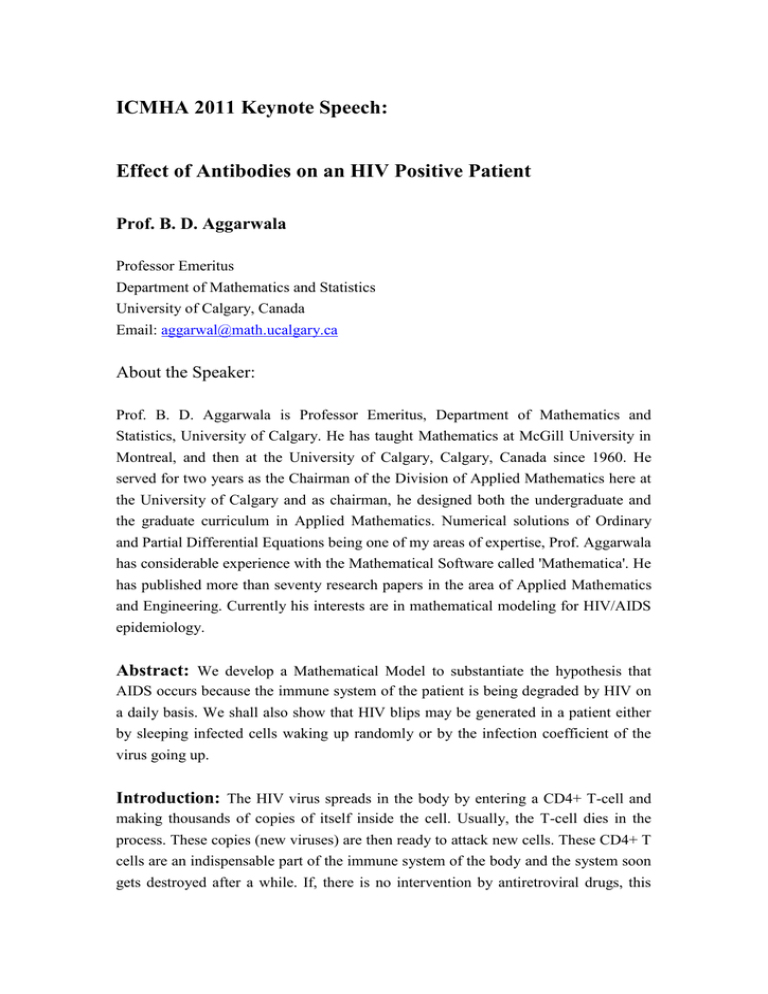ICMHA 2011 Keynote Speech: Prof. B. D. Aggarwala
advertisement

ICMHA 2011 Keynote Speech: Effect of Antibodies on an HIV Positive Patient Prof. B. D. Aggarwala Professor Emeritus Department of Mathematics and Statistics University of Calgary, Canada Email: aggarwal@math.ucalgary.ca About the Speaker: Prof. B. D. Aggarwala is Professor Emeritus, Department of Mathematics and Statistics, University of Calgary. He has taught Mathematics at McGill University in Montreal, and then at the University of Calgary, Calgary, Canada since 1960. He served for two years as the Chairman of the Division of Applied Mathematics here at the University of Calgary and as chairman, he designed both the undergraduate and the graduate curriculum in Applied Mathematics. Numerical solutions of Ordinary and Partial Differential Equations being one of my areas of expertise, Prof. Aggarwala has considerable experience with the Mathematical Software called 'Mathematica'. He has published more than seventy research papers in the area of Applied Mathematics and Engineering. Currently his interests are in mathematical modeling for HIV/AIDS epidemiology. Abstract: We develop a Mathematical Model to substantiate the hypothesis that AIDS occurs because the immune system of the patient is being degraded by HIV on a daily basis. We shall also show that HIV blips may be generated in a patient either by sleeping infected cells waking up randomly or by the infection coefficient of the virus going up. Introduction: The HIV virus spreads in the body by entering a CD4+ T-cell and making thousands of copies of itself inside the cell. Usually, the T-cell dies in the process. These copies (new viruses) are then ready to attack new cells. These CD4+ T cells are an indispensable part of the immune system of the body and the system soon gets destroyed after a while. If, there is no intervention by antiretroviral drugs, this happens in about ten years. But, every time a virus makes a copy of itself, it is different from its original copy at approximately one location (called a nucleotide). This mistake lends a tremendous advantage to the virus. This is because when the immune system of the body attacks the virus, its antibodies recognise the virus by some markers on a T-cell's surface that the virus prompts. These markers are called "epitopes". Many of these epitopes are variable and may change as the virus changes at one neucleotide and then at another in response to pressure from the immune system of the body. Sometimes such changes can cause an epitope to become invisible to the immune system, making the virus more difficult for the antibodies of the immune system to detect and destroy it. If therefore, the immune system of the body recognises the virus through its variable epitopes, then the capacity of the immune system to recognise the virus will degrade as more and more of these variable epitopes undergo evolution (the change we have described) and become invisible to the immune system. Thus, after a while, the viruses will grow unchecked. However, this war between the virus and the immune system is not one sided. The immune system recovers from its incapacity to recognise new epitopes, so that the "survival advantage" thus conferred on the virus is short lived. After a short time, the immune system attacks the virus with improved antibody fitness and the virus begins to decline. This game of cat and mouse continues till finally the virus gains the upper hand (because the number of undetectable epitopes continues to increase). In the last stage of the game, the patient develops AIDS. An epitope, therefore, may be considered as the signature of the virus and the virus, in its quest to survive, keeps on changing its signature so that it is more and more difficult for the immune system of the body to recognise the virus. In order to survive inside the body (it cannot survive outside the body for very long), it does three things. One, it constantly changes its 'signature', and thus hides from the immune system of the body. Two, it becomes more and more 'virulent' and attacks and kills more and more immune cells of the body so that such cells become depleted. But since more and more of them are being produced in the body, getting infected, producing more viruses, and dying, the phenomenon results in what are called 'HIV blips' in the HIV literature. And finally, it learns to hide inside some of the 'resting' cells. These are the cells that do not exhibit the signature of the virus on their surface and the virus may hide inside of them for months, even years and then show up suddenly, so that it is very difficult to eradicate this disease entirely. There are other viruses that have this property and this is why the 'shingles' in your body may appear after they have shown no sign of being there for years. Are the HIV blips the "shingles" in the body of an HIV positive person? In this paper, we develop a mathematical model to study the phenomenon of decreasing effectiveness of antibodies, and give several examples to indicate that if the parameter in the system that measures the effectiveness of the immune system, decreases with time then the number of healthy cells decreases and the number of virions increases with time. The intermittent increase in antibody effectiveness, which happens when the evolutionary pressure on the virus declines, or which may occur when specific cytokines (IL-2 is an example) are delivered to the system, is modelled by an impulsive differential equation in our model. It has been pointed out in the literature that on activation by IL-2, the killer cells of the body proliferate, even as they become better killers and produce additional cytokines. As with any mathematical model, we can quantify this change to conclude that in a given patient, this antibody effectiveness is going down at this rate. This would, hopefully, lead to individualised and more efficient medical prescriptions for patients. We also study the phenomenon of HIV blips in an HIV positive patient. After a patient has been treated with antiretrovirals and his viral load has been below the detection level (i.e. less than 50 copies/ml today), his viral load suddenly goes up to above 1000 copies /ml and then comes down. Such movements of the viral load are called HIV blips. We shall show that, in our model, these blips may be generated by the latently infected cells coming to life and producing virions. Since this phenomenon may occur at random, these blips may indeed be random as has been claimed in the HIV literature. However, in our model, these blips may also be generated as the infection coefficient of the disease increases. So that the blips may also be generated signalling a failure of the treatment.


